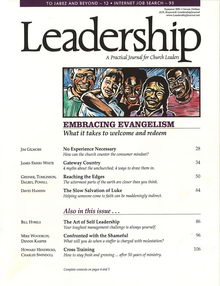No preacher really wants to admit this, but every Sunday morning we are just working out our own stuff with God in front of the congregation.
That sounds a lot worse than it really is. It isn’t necessarily manipulative, self-indulgent, or exhibitionist. It may be the congregation’s only hope for hearing God’s response to their own sacred yearnings.
The best sermons are constructed not in the head but in the soul of the preacher. These are the messages that arise out of the depths of our own angst, fears, doubts, and struggles with God. When the congregation listens to a sermon they know immediately if the preacher is being spiritually honest, or if they are about to hear another detached exegetical analysis of the text. Clearly, good preaching cannot avoid biblical exegesis. But there is a difference in talking about the Word and proclaiming it. And the preacher can only proclaim the Word he or she knows, all too personally.
This doesn’t mean that the preacher should always be explicit about his or her struggles or personal feelings about the text. That gets awfully old, awfully fast. Rather it means that the preacher’s own soul is on the line every time a new sermon is written. If the sermon hasn’t already beaten the preacher on the head and shoulders all week long, why should we expect it to offer any transformation to those who listen in on Sunday morning?
This assumes that the preacher’s issues and questions about God are the same as those of the congregation.
The fundamental struggle many preachers have is not that they are writing bad sermons, but irrelevant ones. That happens when we unconsciously preach to the congregation we used to have, or want to have. It also happens when the preacher doesn’t have enough self-knowledge to understand why the same irrelevant themes keep emerging in the sermon.
Our pastoral search committees spend a lot of time trying to make sure their candidate is the right “gift match” for the congregation. I wonder if they don’t work too hard on that. What they should really be concerned about is making sure that the pastor is the right neurotic match for the congregation.
So what should happen when the preacher’s theological questions are radically different from those of the congregation? Well, it may be time to talk to another search committee, but not necessarily. If the preacher feels called by God to stay, then that is also a calling to be overhauled by the Holy Spirit in order to be a useful instrument of God’s work in that church.
A critical moment comes in every pastorate when you have to decide if you will surrender to the congregation you have. Another way of saying this: you choose to love them as they are today. Not for what you hope your ministry will turn them into tomorrow.
The day you give in to this calling is the day you make room in your soul for the concerns of the people in your congregation. That means that out of love you are now bearing their issues with God, even if it makes you crazy. Which it will. But then your preaching becomes an ongoing sacred conversation between the laments of your people and the faithful Word of God.
Besides, going crazy for a congregation is exactly what it means to accept ordination.
M. Craig Barnes is pastor of National Presbyterian Church in Washington, D.C., and editor-at-large of Leadership.
Squeezing More from Your Story
John Ortberg turns everyday events into captivating sermon illustrations. A story that other preachers would tell in half a minute, Ortberg stretches to three or four minutes. And every turn the story takes has bearing on the sermon. We asked Ortberg, a teaching pastor at Willow Creek Community Church in suburban Chicago, how he does it.
Why do you tell longer stories?
Especially for the people who are outside the church, I want to communicate that I live in the real world, their world. The single largest source is the people themselves—staying immersed in their lives and telling their stories, because story communicates deeply.
What clues you to a story that should be told?
In seminary Ian Pitt-Watson taught us the preacher has two tasks: exegesis of the text and exegesis of life. There are all kinds of moments in life when Jesus is present. If I learn to look diligently and creatively enough, I can find him there, and I can proclaim his presence. There’s a little piece of my mind that is always doing that, looking for ways to exegete life. I hear things people say, or I pick up a story and it strikes me, That’ll teach. Those moments are the slices of life that make good teaching.
How do you develop a three-sentence illustration into a full-fledged story?
I look for illustrations with language and images that work on multiple levels. Then I ask, “What is the doctrinal truth present in this situation?” Thinking about basic themes already there—like brokenness or persistent love—and asking how these things are demonstrated in the story causes the illustration to deepen. The vast majority of us as teachers and preachers don’t squeeze nearly all the blood out of our turnip. A lot of people don’t take the time to think creatively about connections between everyday stories and theological truths.
Give us an example of squeezing the turnip.
Years ago a group of us were playing Trivial Pursuit. My mother-in-law asked my wife a trick question: “What color is Mona Lisa’s necklace?” (She wasn’t wearing one.) My wife was furious, and the rest of us were laughing. That later became the theme of a message I was doing on Ecclesiastes. The game was hot, everyone was talking about it, and I preached that all life is vanity, a trivial pursuit.
I kept repeating the phrase “trivial pursuit” as I preached on the busyness of life, running errands, and such. Then there’s the trivial pursuit of Ecclesiastes: learning, achievements, wealth, and pleasure. You can chase these things, but you eventually find this, too, is just a trivial pursuit. The story and the phrase started on a light, easy-to-relate-to level, and then got deeper.
I also inverted the idea, gave it a twist. Out of the whole universe there’s one little planet of fallen, bent people, and yet God decides they are worth sending his Son to the cross. The God of the whole universe goes after this one little bent planet, but in God’s mind, it’s not a trivial pursuit.
How do you decide whether a slice-of-life illustration will work?
The three laws of real estate are location, location, location. The same with illustrations. Does it really fit where I’ve placed it? When an illustration is right in the flow of what we’re talking about so that it becomes deeply, intrinsically, organically connected, it works.
Sometimes a great story, no matter how well told, just doesn’t fit. It’s then I have to discipline myself to say, “Have enough trust in God not to use that illustration now; save it for another time.” Eventually the Holy Spirit brings it back to mind, when the sermon—and the fit—are right.
This interview is from PreachingToday.com, an online journal and illustration service from the editors of Leadership.
Movie clips to Show or Tell
Set-up: Benjamin Martin (portrayed by Mel Gibson) is a reluctant soldier in the Revolutionary War. His 18-year-old son, Gabriel, however, is eager to join the conflict. Gabriel’s sentiments for his country are revealed by his one obsession: throughout the first half of the movie, Gabriel diligently repairs an American flag that he found in the dirt.
Tragically, when Gabriel becomes a casualty of the war, his father is ready to quit the cause. While Martin grieves at the side of his dead son, his commanding officer, Colonel Burwell, tries to persuade Martin not to quit. Martin has great influence with the soldiers, and the colonel knows his departure would be demoralizing.
Synopsis of the scene (show or tell):
“Stay the course, Martin,” the colonel tells the grief-stricken father. “Stay the course.”
“I’ve run the course,” Martin replies.
Resigned to the outcome, the colonel informs the troops. The dejected soldiers ride away, certain they have seen the last of this man they all admire. As Martin loads his son’s personal effects on his horse, though, he finds the American flag that Gabriel had so painstakingly restored. In a moment, the soldiers see Martin in the distance, charging toward them, carrying the flag. Fearless and determined, he rides upright in the saddle, his face like flint, the stars and stripes whipping in the wind. Martin is a symbol of perseverance for the men, and there is a triumphant shout of both relief and excitement from the once-weary troops as they see the patriot crest the hill.
Concluding statement:
Whether leaders at home, school, work or church, we must never underestimate our influence on others. People are watching: soldiers look to officers, children look to parents. We must stay the course.
Submitted by David Slagle, Lawrenceville, Georgia
New movie clips are available each week from PreachingToday.com, our online journal and illustration service.
Do I need permission to show movies (even short clips) in church?
Yes. You could argue the “fair use” rule for using snippets of movies for sermon illustrations—that’s what allows preachers to quote bits from books and articles—but the safer and more ethical approach is to purchase a license.
It works a lot like your CCLI license to print or project song lyrics.
In fact, Christian Copyright Licensing International (CCLI) has recently partnered with Motion Picture Licensing Corporation to offer a service especially for churches. Church Video Licensing (CVLI) offers an “umbrella license” for an annual fee.
You can show authorized titles from MPLC’s long list of big studios (including Sony, Warner Bros., and Disney) and from a growing list of Christian movie producers. This license covers clips in sermons, plus videos shown in classes, youth groups, and events such as family film nights, so long as no admission is charged and the title is not advertised to the general public.
Fees are based a church size: $150 for churches with average attendance up to 500, $200 for churches above 500.
Smaller churches can license the religious titles only, if they wish: $45 for churches under 100, $75 for under 200.
Licenses can be granted over the phone, just in time for your next sizzling sermon illustration or Sunday night’s Billy Graham film. Contact CVLI at 888-771-2854 (CVLI). www.cvli.org
—The Editors
Worship Team Relay
Why two squads are better than oneWorship teams can’t give every week, 52 weeks per year. I’ve been a part of different churches that used different systems, and I’m sold on intentional pacing of worship leaders, singers, and musicians. We have two teams: one team leads worship the first two weeks of the month, and the other team leads the latter two weeks. Rehearsal attendance is only expected on the week prior to the assigned Sunday. We plan special worship events, or youth team worship, on any fifth Sunday services.
We design our rehearsals to maximize logistical and spiritual preparation. After beginning in prayer, our vocalists and instrumentalists break out into section-specific training for an hour. Practice needs satisfied, we then join together for a rehearsal that can swiftly move from practice to genuine worship. We then spend fifteen minutes discussing either next Sunday’s passage or a book on spiritual growth. Finally, we conclude in prayer both for one another and for the upcoming service.
Every other month we plan a social or team-building event. Artists love to hang out and eat. Fortunately, those two activities contribute to good working relationships. We particularly enjoy going to a local bookstore or coffee shop to, well, hang out. We’ve also gathered in one another’s homes for dinner and traveled together to nearby worship conferences. Including spouses in these activities has also proven to build team cohesion and commitment.
Joe Key, worship pastorFellowship Evangelical Free ChurchKnoxville, Tennessee
Seasoning for Sunday
Passing the Hat
At a high point in baseball season, demonstrate “cheerful giving.” Describe the crowd at a game. Perhaps lead a few cheers. Next, read 2 Corinthians 9:7-8, and explain what Paul means by giving with “hilarity.” Then have the ushers pass the hats, substituting baseball caps for offering plates, and ask the organist to pull out all the stops, “Wrigley Field” style. This also works with helmets in football season.
Greeters, Greeters Everywhere
September usually brings higher visitor traffic. So in August, before the guests arrive, show the congregation the importance of a warm welcome.
Before the service, designate two volunteers to serve as “official greeters.” Instruct them to tell the first people they meet that help is needed greeting attenders, and designate them also as “official greeters.” These people, before they sit down, must greet at least three people, and designate them as “official greeters.” And so on.
By the time service begins, everyone has been greeted and designated as an “official greeter.” The stage is set for a message on making people feel welcome.
—from Innovative Worship: 95 Easy Worship-Enhancing Ideas (Group Publishing, 1999)
Top 25 Worship Songs
What’s Hot Down UnderNot much has changed on CCLI’s short list since we published it last year. Only four new titles appeared in the U.S. ranking: “Open the Eyes of My Heart,” “You Are My All in All,” “I Could Sing of Your Love Forever,” and “My Life Is in You.”
But we’ve felt a groundswell from down under, with Aussie songwriters contributing to worship around the planet. So we thought it might be helpful to publish CCLI’s Top 25 from reporting churches in Australia.
1. Shout to the Lord (D. Zschech)
2. Lord I Lift Your Name On High (R. Founds)
3. My Redeemer Lives (R. Morgan)
4. Ancient of Days (Harvill & Sadler)
5. Power of Your Love (G. Bullock)
6. What the Lord Has Done In Me (R. Morgan)
7. Hear Our Praises (R. Morgan)
8. The Potter’s Hand (D. Zschech)
9. I Give You My Heart (R. Morgan)
10. Eagles Wings (R. Morgan)
11. Jesus, What a Beautiful Name (T. Riches)
12. Shine, Jesus, Shine (G. Kendrick)
13. This Kingdom (G. Bullock)
14. All Things Are Possible (D. Zschech)
15. This Is How We Overcome (R. Morgan)
16. There Is a Redeemer (M. Green)
17. The Heavens Shall Declare (G. Bullock)
18. Great In Power (R. Fragar)
19. As the Deer (M. Nystrom)
20. Just Let Me Say (G. Bullock)
21. Amazing Love (G. Kendrick)
22. Give Thanks (H. Smith)
23. Have Faith In God (G. Bullock)
24. Refresh My Heart (G. Bullock)
25. You Said (R. Morgan)
Copyright © 2001 by the author or Christianity Today/Leadership journal. Click here for reprint information on Leadership.









